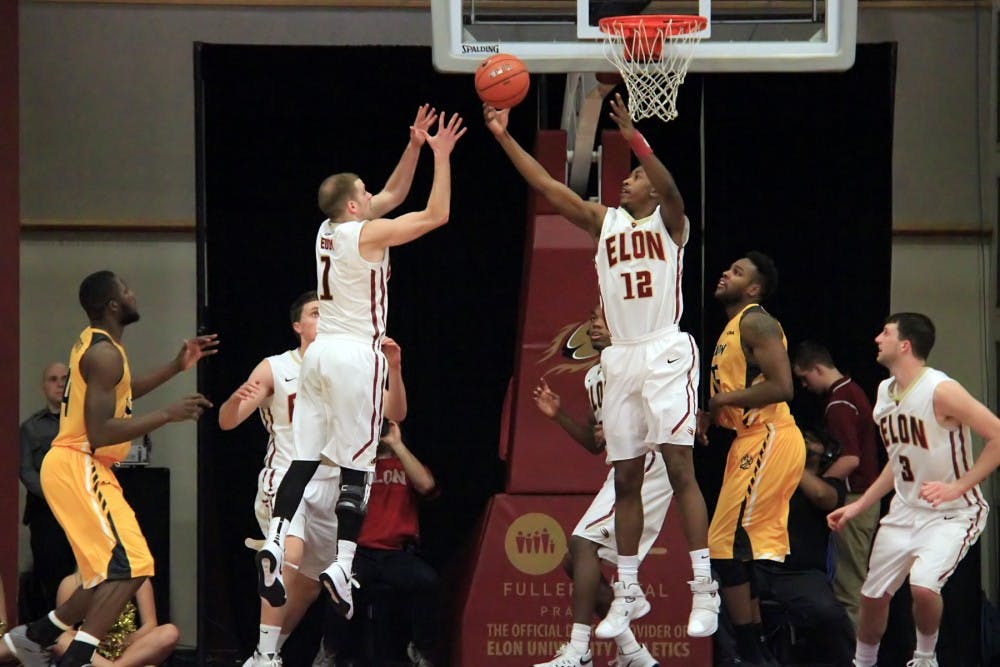The Elon University men’s basketball team knows its inherent limitations in the recruiting realm. Non-power conferences often fall short of drawing five-star, blue-chip recruits, with the exception of the occasional “hometown kid” or coach’s son.
Mid-major programs must look to find an edge elsewhere, and with the recent move to the Colonial Athletic Association (CAA), the Phoenix has zeroed in on different types of players — not the prospects who jump over the moon, but young basketball players with incredibly high basketball IQs.
An equal-opportunity offense
Even when Elon is struggling from behind the 3-point line or unable to get out in transition — two slices of its offense’s bread and butter — head coach Matt Matheny can fall back on his players having a feel for the game.
Such was put on display in the victory over University of Delaware Thursday — players knew when to cut backdoor, duck into the post from the weak side or make the extra pass even when the offense isn’t humming as much as they’d like.
“I think we do have pretty high basketball IQs,” Matheny said. “What we are trying to develop is an equal opportunity offense. We need post players that can stretch defenses, but can also pass and catch.
“We need guards that can take the ball inside, so we want to be a team that’s difficult to guard inside and out. You need to have multiple guys that can pass the ball and catch the ball.”
That’s precisely what Elon has done — construct an equal-opportunity system predicated not on individual talent or freelancing, but on superior tempo and, most importantly, superior decision-making.
According to Ken Pomeroy’s advanced metrics on KenPom.com, Elon has the 18th-highest tempo of the 346 Division I basketball teams, and goes through possessions at the 29th-quickest rate.
Elon’s also 66th in the nation in assist percentage, with 57.6 percent of made field goals being assisted, as well as 12th in 3-point attempt rate.
It’s a fairly generic motion offense, but few teams utilize it like Elon. The players push the ball up the floor every possession, swinging the ball around the perimeter and moving opposing defenders around before throwing screens at them from different directions, both on and off the ball, until they can find an open shot — usually a spot-up 3-pointer or a driving shot at the rim.
Senior guard Tanner Samson, the school’s all-time leader in 3-pointers who attempts more than seven shots from long range per game, is assisted on most of his 3-point shots. Playing with junior guard Luke Eddy certainly doesn’t hurt — a crucial cog in the rotation, Eddy is 43rd in the nation in Assist Rate (33.8), good for second in the CAA.
Another edge to explore
Another area Elon has looked to find extra edges is in the offensive rebounding department. Elon has struggled on defense this season, and getting beat defensively to crash the offensive glass may be a worthwhile gamble for them, considering how they’ve fared there thus far.
“Yes, [offensive rebounding] is something we’ve talked a lot about,” Matheny said. “And that’s another way to manufacture points when we’re not making threes. We don’t have Dikembe Mutombo. We don’t have Dennis Rodman. We don’t have guys that just have glue on their hands to rebound it.”
It’s a newer point of emphasis for Elon, but the Phoenix is starting to see some success come from it. Junior guard/forward Christian Hairston, sophomore guard Dmitri Thompson and freshman forward Tyler Seibring can all be found in the conference’s top-30 in offensive rebounding rate. As Matheny noted, it’s another mechanism the team can use to help manufacture points when Elon needs baskets.
Elon’s coaching staff appears to be approaching the game in calculated and measured way. For a program that doesn’t have the recruiting zeal or the pull of a Power-Five conference school, it’s the only approach that makes sense.
In its second season in the CAA, Elon seems to be seeing it pay tangible dividends.


